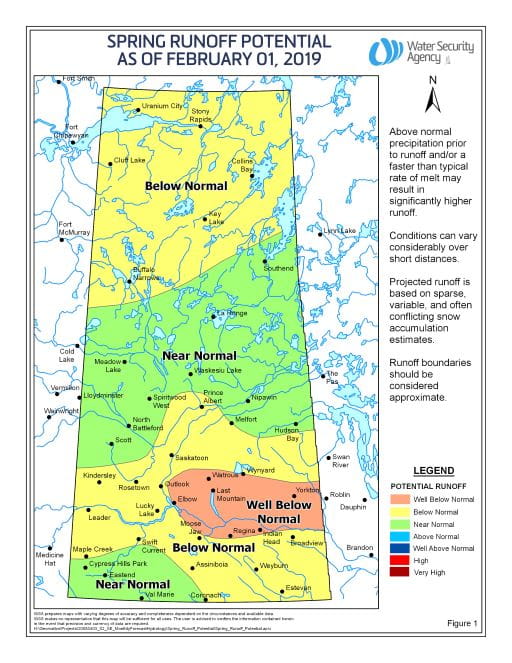Released on February 7, 2019
Today, the Water Security Agency (WSA) released the preliminary spring runoff outlook for 2019.
With the dry conditions in the summer and fall of 2018 combined with below normal winter precipitation so far, below normal spring runoff is expected across most of southern Saskatchewan.
The summer of 2018 saw extremely low rainfall across a large portion of southern Saskatchewan with near record dry conditions in some locations. These conditions continued into the fall where precipitation was also below normal. As a result, soil moisture conditions were dry at freeze-up and significant wetland storage was available in many areas.
There is a band through the northern agricultural region and southern boreal forest where, based on current conditions, near normal snowmelt runoff is expected. Below normal snowmelt runoff is also expected over the far north.
The spring runoff outlook could change as there is potentially another 8-10 weeks of winter remaining. However, with dry fall conditions and below average winter precipitation to date, it would take well above average precipitation in February, March and April to produce an above average spring runoff within most areas.
With below or well below normal snowmelt runoff expected in the spring of 2019, it is anticipated that there could be some agricultural water supply shortages similar to 2018. These issues will likely intensify and expand across southern Saskatchewan. This could also create some surface water supply issues for municipalities and irrigators if conditions remain dry into the summer months.
Unless conditions change significantly, WSA will be aggressive in storing water during the snowmelt runoff period to ensure water supplies are adequate and lake levels are desirable for recreational uses through 2019.
As conditions change and get closer to spring runoff WSA will issue another updated forecast in March.
-30-
For more information, contact:
Patrick Boyle
Water Security Agency
Moose Jaw
Phone: 306-694-8914
Email: Patrick.Boyle@wsask.ca
Cell: 306-631-6997

